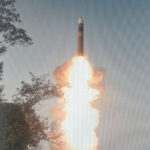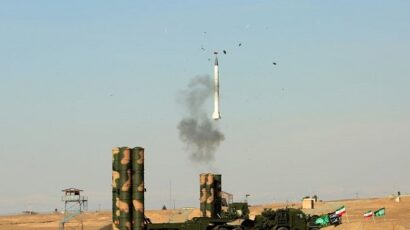Republicans, missile defense, and the Reagan legacy
By Bulletin staff | April 25, 2008
When developing a weapons program for the Defense Department, there is normally an orderly and somewhat rational process to be followed: First, a threat is identified; research is then conducted on how best to deal with said threat; and finally, a weapon system is developed and eventually produced.
If at any time in this process the threat changes or the research demonstrates that no available technology exists to deal with the threat, or a weapon system cannot be developed in a cost-effective manner, the research is stopped, slowed down, or canceled.
There is no doubt that sometimes bias, organizational culture, or ideology becomes a part of the process. Threats can be hyped, research and development skewed, and the capabilities of a new weapons system exaggerated. But rarely does this process become completely irrational. It is possible to have a reasonable, rational debate about whether the United States should purchase the F-22 fighter aircraft, the DDG-1000 destroyer, or V-22 helicopter.
But this is not the case with national missile defense, which owes its origin to President Ronald Reagan’s 1983 Strategic Defense Initiative speech challenging the country to develop a defense system that would provide the United States with the ability to destroy any and all nuclear-equipped intercontinental ballistic missiles (ICBM) launched against Washington by the former Soviet Union. Reagan believed that a successful missile defense could both end the nuclear arms race and make nuclear weapons obsolete. He even went so far as to promise to share the technology with the Soviets. In what would be a harbinger of things to come, Reagan did not consult with either the military or Defense’s civilian leadership before unveiling his proposal.
In the 25 years since Reagan’s speech, the United States has spent hundreds of billions of dollars on missile defense, the Soviet Union has collapsed, and the national missile defense system has not undergone a realistic test. Yet, ground-based national missile defense systems have been deployed, most Republicans argue that it should be the Pentagon’s top priority, and the Bush administration continues to pour tens of billions of dollars into missile defense each year. National missile defense is the only weapons system mentioned in the last three Republican presidential platforms and the Contract with America, the Republican manifesto that led to the party assuming control of Congress in 1994. Why?
For starters, it has become a litmus test of loyalty to the Reagan legacy. President Reagan has assumed the same iconic place for Republicans that Franklin Delano Roosevelt had for so many years for Democrats. For example, John McCain, the presumptive Republican presidential nominee, often refers to himself as a foot soldier in the Reagan Revolution, as did his former opponents Mitt Romney and Rudolph Giuliani. This revolution was based on three pillars–pro-life as opposed to pro-choice; government as the cause of society’s problems as opposed to the solution; and a robust national missile defense as opposed to arms control negotiations or disarmament.
Some Republicans have difficulty completely supporting the first two pillars: The majority of Americans want to place only a few restrictions on a woman’s right to choose and view government as a solution to many of our economic and social problems. But there is no political downside for a Republican to embrace missile defense. Most Americans either believe we already have a missile defense capability or really do not care much about it now that the Cold War has ended. National missile defense may be mentioned in the Contract with America or the Republican platform, but nobody reads these documents, let alone votes based on their contents.
In addition, a foolproof national missile defense would enable Republicans to go it alone in the world and not have to rely on other nations or international treaties to provide security. This philosophy can be summed up as “unilateral if we can, multilateral if we must.” Thus, if national missile defense can protect the United States against North Korean, Iranian, or Chinese missiles, why negotiate or make concessions? Or if the Anti-Ballistic Missile (ABM) Treaty with Russia prevents Washington from forging ahead with national missile defense, why not just scrap the treaty regardless of how it affects U.S.-Russian relations? Or why ratify the Comprehensive Test Ban Treaty or the Fissile Material Cutoff Treaty? Instead, move ahead with the development of the bunker-buster or the reliable replacement warhead.
Consequently, when the Republicans are in power, they push missile defense relentlessly. After the Republicans won both the Senate and House of Representatives in 1995, they passed a law, the National Missile Defense Act, which said that it was U.S. policy to deploy national missile defense as soon as possible. Never mind that the Soviet Union had collapsed, that the Clinton administration had just concluded an agreement with North Korea to freeze its development of plutonium at Yongbyon, or that there was no evidence then that Iran was violating the Nuclear Non-Proliferation Treaty.
Similarly, when President George W. Bush took office, he immediately doubled missile defense spending, gave notice that Washington would withdraw from the ABM Treaty, and cut off negotiations with North Korea. Moreover, since he was not sure he would be reelected in 2004, he accelerated the deployment of ground-based missiles in California and Alaska even though the system had failed virtually all of its tests up to then.
Bush’s obsession with missile defense continues today. At the recent NATO summit, the president made deployment of radars and ground-based missiles in Poland and the Czech Republic his first priority. For him, it was more important than getting NATO to provide more troops to the deteriorating situation in Afghanistan or improving relations with Russia.
Richard Garwin, a distinguished physicist who helped develop the hydrogen bomb and served on the Rumsfeld Commission that Congress established in 1996 to analyze the ICBM threat, put it well when he said, “The strongest proponents of national missile defense have no technical understanding at all.” Another scientist, Philip Coyle, the Pentagon’s director of operational test and evaluation from 1994 to 2001, noted that it is not in the cards to ever have a Plexiglas dome over the United States in which enemy missiles will be like hail bouncing off of a windshield. Yet, many Republicans believe that this can and will be done and continue to make national missile defense the largest single investment program in the Defense Department–i.e., $13.2 billion for missile defense in 2009. Sen. Joseph Biden, a Democrat from Delaware, summed it up best when he commented on the National Missile Defense Act in 1999: “Perhaps the real clash here is between ideology and reality.”
Together, we make the world safer.
The Bulletin elevates expert voices above the noise. But as an independent nonprofit organization, our operations depend on the support of readers like you. Help us continue to deliver quality journalism that holds leaders accountable. Your support of our work at any level is important. In return, we promise our coverage will be understandable, influential, vigilant, solution-oriented, and fair-minded. Together we can make a difference.
Topics: Nuclear Weapons, Opinion














